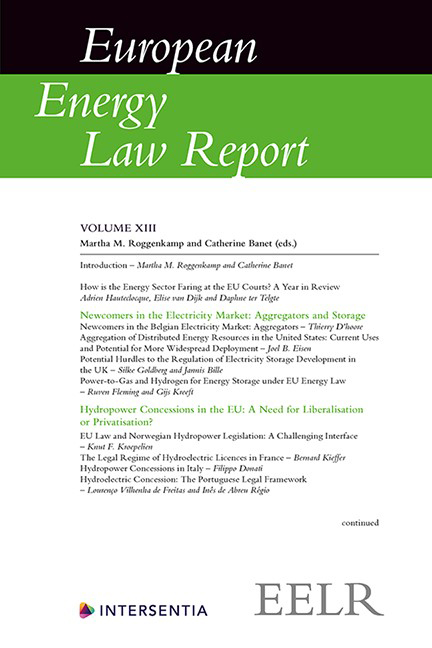Book contents
- Frontmatter
- Preface
- Contents
- List of Abbreviations
- List of Contributors
- Introduction
- Chapter I How is the Energy Sector Faring at the EU Courts? A Year in Review
- PART I NEWCOMERS IN THE ELECTRICITY MARKET: AGGREGATORS AND STORAGE
- PART II HYDROPOWER CONCESSIONS IN THE EU: A NEED FOR LIBERALISATION OR PRIVATISATION?
- PART III INVESTMENTS AND DISINVESTMENTS IN THE ENERGY SECTOR
- PART IV OFFSHORE DECOMMISSIONING IN THE NORTH SEA
- PART V CCS AS A CLIMATE TOOL: NORTH SEA PRACTICE
- PART VI FROM EU CLIMATE GOALS TO NATIONAL CLIMATE LAWS
Chapter XXI - A Stocktake of Legal Research on the United Kingdom’s Climate Change Act: Present Understandings, Future Opportunities
Published online by Cambridge University Press: 30 April 2020
- Frontmatter
- Preface
- Contents
- List of Abbreviations
- List of Contributors
- Introduction
- Chapter I How is the Energy Sector Faring at the EU Courts? A Year in Review
- PART I NEWCOMERS IN THE ELECTRICITY MARKET: AGGREGATORS AND STORAGE
- PART II HYDROPOWER CONCESSIONS IN THE EU: A NEED FOR LIBERALISATION OR PRIVATISATION?
- PART III INVESTMENTS AND DISINVESTMENTS IN THE ENERGY SECTOR
- PART IV OFFSHORE DECOMMISSIONING IN THE NORTH SEA
- PART V CCS AS A CLIMATE TOOL: NORTH SEA PRACTICE
- PART VI FROM EU CLIMATE GOALS TO NATIONAL CLIMATE LAWS
Summary
INTRODUCTION
When the UK Parliament's Climate Change Act 2008 (CCA) was passed into law it was the first time a country employed national framework legislation to impose economy-wide legally binding long-term emissions reduction targets upon itself in the interest of combatting climate change. One should not over- simplify the drivers behind the CCA's creation by reducing them purely to a response to challenges posed by anthropogenic climate change. Geopolitical concerns pertaining to the issue of UK energy security also acted as a substantial regime driver. Nevertheless, the contribution of this pioneering framework has been widely – and deservedly – recognised. Despite its imperfections, it is ‘one of the most important items of legislation passed by any national Parliament in the world in modern times.’
This chapter starts by reviewing the background to the adoption of the CCA (Section 2). It continues by outlining the Act's main features (Section 3). It then provides evaluative reflection and comment on the legal research analysing it (Section 4). In doing so, it also addresses and comments on ways forward for the literature. Finally, it ends with some concluding remarks (Section 5).
BACKGROUND TO THE ADOPTION OF THE CLIMATE CHANGE ACT
The CCA was passed by the UK Parliament on 26 November 2008. In implementing the framework legislation, the UK supplanted a soft policy- oriented regime with a more substantial and robust statutory one. The socio- political background and internal conditions that generated the emergence of the framework were complex. It should also be noted that this particular type of legislative scheme was relatively novel and radical in the context of conventional UK law-making at the time, and that it remains so today.
- Type
- Chapter
- Information
- European Energy Law Report XIII , pp. 421 - 442Publisher: IntersentiaPrint publication year: 2020
- 3
- Cited by



